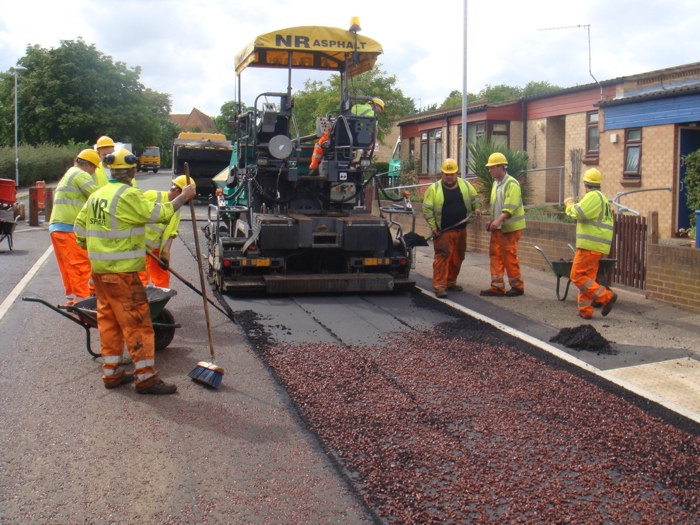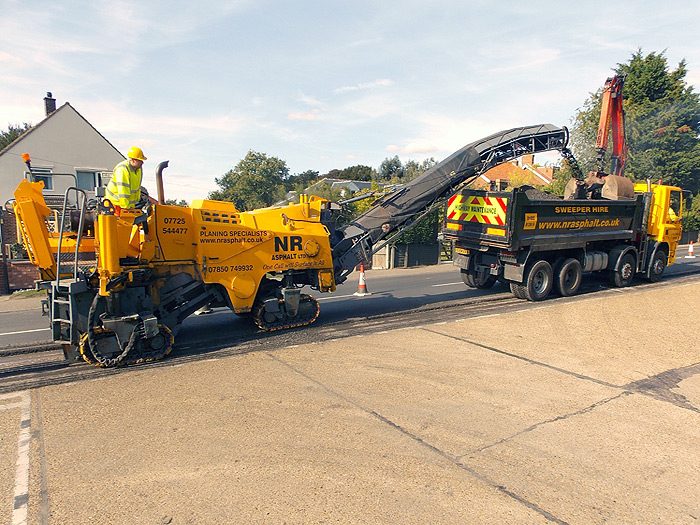Bituminous mixing and laying plant
Contents |
[edit] Introduction
The mixing and laying of bitumen for roads and pavements can be undertaken using a range of different types of plant. The type of plant used will be determined by the type of material that is required and the process adopted.
[edit] Heaters and boilers
Bitumen heaters and boilers range from small mobile units to large permanent plant. The most common types are:
- Mobile boilers: Mounted on a steel chassis and towed from place to place. The furnace at the base of the boiler is either gas or oil-fired.
- Static heating and storage tanks: These are heated by oil-fired burners and are available for high outputs as they can have capacities of up to 18,000 litres. They will usually be transported on a low loader.
[edit] Binder distributors
The most common type of binder distributor is the bulk tank sprayer. The binder is kept at the required temperature by fitted heating units. A static heating unit feeds the binder into the bulk tanker which can have a range of tank capacities. A horizontal spray bar and power-driven pump mounted at the rear of the unit is used to spray the binder over the road surface.
[edit] High speed road-surfacing units
These are commonly used in resurfacing projects. The road is sprayed with hot binder and then coated with grit from a slow-moving machine. A lorry follows behind the chip-spreader to keep it supplied with chippings. These are fed into a rear hopper and carried on a conveyor to the spreader.
[edit] Road planers and heaters
Road planers heat the bituminous road surface until soft and then make it even by using revolving blades. The blades cut away to leave a smooth surface that can then be treated as required.
Road heaters are used on road surfaces that have become too smooth. They dry, heat and burn the road surface to enable further treatment as required.
[edit] Asphalt and bitumen mixing plant
These are either permanent plant installations or small mobile units. They perform a complete sequence of operations, from drying, to aggregate heating and mixing, to coating them with binder, to delivering them ready to be laid.
- Drying units: A long rotating cylindrical drum is heated internally by hot gases through which the aggregate is passed, ensuring that it is thoroughly dry before being coated with a binder.
- Batch-mixing plants: These have several individual sections – aggregate feeder, drier unit, binder heater, weighing plant and mechanical mixer.
- Mixing units: These are a form of paddle mixer that enables a thorough mix in a short space of time.
[edit] Spreading and finishing plant
Large machines are used for spreading and finishing the surface coating, ideally in a single pass. They are available with different laying speeds and hopper capacities. Rollers on the front of the lorry’s hopper are connected to the tyres and so push the lorry forward whilst unloading. The screed plate is hydraulically adjusted so as to control the thickness of the surface finish.
[edit] Find out more
[edit] Related articles on Designing Buildings Wiki
- Code of Practice for Ironwork Systems Installation and Refurbishment.
- Compressed air plant.
- Concreting plant.
- Construction plant.
- Construction tools.
- Crane supports.
- Earth-moving plant.
- Excavating plant.
- Forklift truck.
- Hoist.
- Kerbs.
- Pavement.
- Power float.
- Road construction.
- Road joints.
- Runway construction.
- Scaffolding.
- Stacker.
- Types of crane.
- Types of road and street.
- Types of roller.
[edit] External references
- ‘Introduction to Civil Engineering Construction’ (3rd ed.), HOLMES, R., The College of Estate Management, (1995)
Featured articles and news
Moisture, fire safety and emerging trends in living walls
How wet is your wall?
Current policy explained and newly published consultation by the UK and Welsh Governments.
British architecture 1919–39. Book review.
Conservation of listed prefabs in Moseley.
Energy industry calls for urgent reform.
Heritage staff wellbeing at work survey.
A five minute introduction.
50th Golden anniversary ECA Edmundson apprentice award
Showcasing the very best electrotechnical and engineering services for half a century.
Welsh government consults on HRBs and reg changes
Seeking feedback on a new regulatory regime and a broad range of issues.
CIOB Client Guide (2nd edition) March 2025
Free download covering statutory dutyholder roles under the Building Safety Act and much more.
AI and automation in 3D modelling and spatial design
Can almost half of design development tasks be automated?
Minister quizzed, as responsibility transfers to MHCLG and BSR publishes new building control guidance.
UK environmental regulations reform 2025
Amid wider new approaches to ensure regulators and regulation support growth.
The maintenance challenge of tenements.
BSRIA Statutory Compliance Inspection Checklist
BG80/2025 now significantly updated to include requirements related to important changes in legislation.
Shortlist for the 2025 Roofscape Design Awards
Talent and innovation showcase announcement from the trussed rafter industry.

























Comments
I think I like this article because it summarizes into details and its points are clear and how I wish you explained how Bitumen laying operation is done. The information will be so much useful.